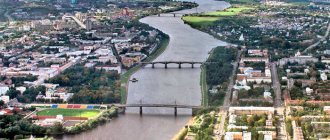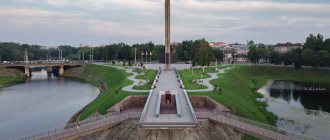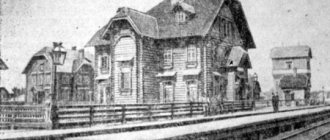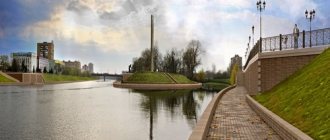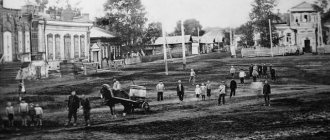Tver is ancient. Where did the name come from, or five versions of the origin of the word “Tver”
The Tverigrad.ru portal and the famous Tver blogger and local historian Igor Marchenkoff present the one hundred and thirty-second issue of the “Ancient Tver” project, in which photographs, images, facts, stories and legends show what the city was like yesterday and what it has become today.
Today we will remember five versions of the origin of the word “Tver”. But let's start with the fact that Tver arose as a city at the mouth of the Tmaka River. In the early 30s, archaeologists conducted excavations here, the purpose of which was to clarify the time of the emergence of Tver. Based on the results of excavations, it was determined that the “city” with fortifications was located on a cape near the Tmaka River. The oldest embankment structure (shaft) arose no later than the 12th century. Before this, i.e. in the 11th century there was a rural settlement here. On the left bank of the Volga and near the mouth of the Tvertsa, where the Otroch Monastery was later located, no fortifications or settlements earlier than the 13th century were discovered. Now let’s look at the versions of “where the word Tver came from”:
The hill where Tver was founded
The first version is “Fino-Ugric”
“Tver” is a derivative of the Finnish word “tiort” - “fast”. There is a hypothesis that Tver was founded by Novgorodians, who in the 8th-9th centuries mastered the flows of the Msta and Tvertsa rivers.
The Novgorodians - Ilmen Slovenes - moved to these lands through the lands occupied by newcomers from the east - to the fullest extent. And the Novgorodians did not have the habit of honoring their greats by assigning their names to settlements. They were familiar with the name of the river (Tver, Tfer, Tikhver) and they named the settlement the same. You can quote from the work of V.S. Borzakovsky: “Probably, the Novgorodians founded a settlement at the mouth of the Tvertsa, which received its name from the name of the river; this settlement, as a result of its advantageous position in terms of trade, began to grow rich (like Torzhok, which grew rich for the same reason).” The author further indicates that this is a Novgorod settlement at the end of the 12th century. was fortified by the Suzdal princes already at the beginning of the 13th century. this city was a Suzdal fortress on the Novgorod-Suzdal border. But then they had to found it on the left bank, but there was no settlement there, as excavations proved in the 30s of the 20th century.
But TUAC member P.N. Sveshnikov believed that the word Tver comes from the Finnish root Tes - to shine, and the Finnish ending believe (obviously, it means the word river), and means “brilliant river”.
Adam Olearius Tver in the 1630s
The second version is “Slavic”
"Tver", which originally looked like "T'khver", has Russian roots in the East Slavic languages. For example, “firmament”. The basis for this version of the history of Tver was laid by V.N. Tatishchev.
He noted that in 1182, Prince Vsevolod Yuryevich ordered the construction of Tverd on the Volga “at the mouth of the river” and ordered to “closely watch so that people from Novgorod and Torzhok do not pass to the Volga to steal.” And although historians are wary of the so-called. “Tatishchev’s news”, yet this message from Tatishchev looks logical, since Vsevolod after the events of 1181. I could not help but appreciate the importance of controlling the mouth of the Tvertsa and thereby the movements of Novgorodians in the event of further conflicts.
But the historian did not give any explanation for the etymology of the city’s name. And it’s not a fact that we are talking about Tver.
The third version is “Polish-Lithuanian”
It is based on the fact that the name “Tver” is based on the Polish word “twierdza” - “fortress” and the Lithuanian “tvora” - “fence”, for example, on the territory of Lithuania in ancient times there were the cities of Tverai and Tveresius.
Modern drawing of ancient Tver
The fourth version is “Sanskrit”
It says that the Tvertsa River and the city of Tver go back to the Proto-Indo-European language - /dv;raka/ /dvAraka/ n. Gate, door, border, frontier. If there are no questions with Tver, the toponym is from a hydronym, as usually happens. But Tvertsa, another thing, received a very ancient name from our ancestors.
Let's turn to Sanskrit:
;;;;;; /dv;raka/ /dvAraka/ n. gates; door, ;;;;;; /dv;r// /dvAr// f.
1) hole 2) exit; gates; door
Initially, the words door, gate had meanings in Russian:
Gate - gate - A common Slavic word of Indo-European origin from the same stem as the noun gate. However, it has been suggested that the noun gate may go back to the stem verti - “to lock”. Krylov's etymological dictionary. Gate - I: 1) entrance to the city. The city was usually locked at night or when the enemy approached.
Gates were also called guard fortifications at the portage borders[4]. Gates, guard fortification // Encyclopedic Dictionary of Brockhaus and Efron: in 86 volumes (82 volumes and 4 additional). - St. Petersburg, 1890-1907. other-russian vor “fence, fence”, a derivative with the verbose o/e from *verti “to lock”. The root vor is preserved in the hydronyms: Vor-onezh, Vor-skla, Vor-ona.
During the transition “D” is pronounced as “YOU”, “T”, and “K” in “C” during palatization, a sound change, as a result of which a hard consonant becomes soft, palatal or palatalized, we get “dv;raka”:
As “tyvaratsa”, i.e. Tvertsa, a river flowing into the Volga near Tver. What does it mean: “Gate, door, river closing the approach to the fortress, border of the defense line.” As you know, fortresses were erected at the confluence of two rivers, surrounded by walls and a moat. And on the side not covered by natural boundaries, the most powerful walls, ditch and gates were erected.
It was along this river that the border between the Rostov-Suzdal, and later the Vladimir-Suzdal and Novgorod principalities passed at one time. Everything also seems natural and logical.
Moat of the fortress in the city garden
Fifth version - “from the Tivertsi tribe”
Interesting information about opinions regarding the origin of the word Tver is reported by V.A. Pletnev (member of the Tver Scientific Archival Commission (TUAK)): R.N. Nikulin believed that the river and the city owe their names to the chronicle tribe of Tiverts, who, pressed by Prince Oleg, moved to the extreme northeastern borders of the Russian state. Here they settled along the left tributary of the Volga and gave this river its name, which in the chronicles is transmitted as “Tkhver” or “Tkhfer”. In addition, R.N. Nikulin, as reported by V.A. Pletnev, believed that the name of the city in the sources - Ust-Takhver - indicates its origin from the name of the Tvertsa River, just like the cities of Ust-Yug, Ust-Sysolsk , Ust-Mologa are also named after the names of the rivers (36, p. 173, note 1).
In the photo there is an image of the Tver Kremlin on the icon of Michael and Xenia from the beginning of the 15th century, the hill where Tver was founded, Adam Olearius Tver in the 1630s, the moat of the fortress in the city garden, a modern drawing of ancient Tver.
Sources: Malygin P.D. Tver and Novotorzhsko-Volotsk lands in the XII-XIII centuries. // Formation of a European medieval city. - 1989. - P. 125. V. N. Tatishchev. “History of the Russian State” Encyclopedic Dictionary of F. A. Brockhaus and I. A. Efron, article “Tver” Borzakovsky V.S. History of the Tver Principality. Tver, 1994. Bogdanov S.V. (Tver) The name Tver and Tvertsa in written sources. Tver city. Why is Valery Marininsky named like that?
“Tver tavern” - April 10!
We invite all lovers of history and gastronomic delights on April 10 at 12:30 to the opening of the spring season of the original gastronomic and educational tour “Tver Tavern,” which celebrated its anniversary on Sunday!
Guests on the tour will go through historical places and visit three popular establishments of Tver: the Leningrad restaurant, the Old Suitcase beer pub and the Pino Grigio restaurant.
On the tour "Tver Kabatskaya"
In each of the three restaurants, tour participants will take a fascinating journey into the world of Tver gastronomy with tasting of drinks and dishes of Tver cuisine prepared especially for this tour (this is a surprise in each tour).
Guests of the Tver Kabatskaya tour at the Pino Grigio restaurant
Moreover, in three restaurants, tasting dishes will be presented by chefs (or sous-chefs), and guests will be able to hear a fascinating story about the history of each of them.
This project started before the new year 2021 and already has a lot of reviews, here are some of them:
On the “Tver tavern” tour, stew from the chef. restaurant "Leningrad"
Tatiana Smolenskaya: “The tour was wonderful! Thank you, Igor Marchenkoff, for the informative information! I really didn’t know much! And, of course, surprises from chefs from three restaurants! We spent Christmas Day with pleasure and benefit! I recommend to everyone!".
On the Tver Kabatskaya tour we will definitely taste the first one.
Natalya Evstafieva: “Everything is great, we want to continue! We were several friends, and I will express the general opinion. The tour turned out to be very extensive, both in content and in the number of treats. The excursion was not limited to one topic, which was very nice. We visited several historical places and heard many interesting and little-known historical facts. The passionate storyteller and the professionals who treated us in three establishments in the city turned out to be at their best. Tasty, satisfying, and most importantly, a program compiled with love.”
Duration of the excursion: approximately 3.5-4 hours.
Program cost: 1800 rubles (“All inclusive”, prepayment) Collection point: monument to Afanasy Nikitin Collection time: April 10 at 12:30 Registration by phone: 8-952-063-06-00
We ask all those who signed up not to have a heavy breakfast or lunch before the tour!
Details and reviews can be read here https://tonkosti.ru/gidy/Igor-Marchenkoff-chastnyj-gid-v-Tveri-260803525
The burning of Moscow as revenge for aggressiveness
Subsequently, Muscovites tried to hurt Tver at every opportunity. In 1327, an anti-Mongol uprising began in the northern city - Tver residents beat the tribute collectors. Moscow prince Ivan Kalita and his squad willingly took part in the punitive expedition. Together with the Mongols, he approximately punished and burned Tver, which then hardly recovered for almost half a century.
Burning of Tver. Miniature from a chronicle of the 16th century. (wikipedia.org)
The next stage of the confrontation between the two principalities dates back to the beginning of the reign of Dmitry Ivanovich in Moscow, who had yet to achieve the honor of being called Donskoy. In 1367, the 17-year-old prince decided that Tver, which had not yet recovered from the devastation, would become his easy prey. Mikhail Alexandrovich Tverskoy really did not have enough strength to resist, but he had a strong ally. Mikhail wisely married his sister to the Lithuanian prince Olgerd, a noble commander who had recently completely defeated the Mongols themselves at the Battle of Blue Waters. Olgerd did not refuse to help his brother-in-law.
Frightened by the Lithuanians, Dmitry retreated to Moscow, but did not abandon his plans. He, under the pretext of some church litigation, lured Mikhail to visit him and put him in prison along with his entire retinue. The Tver residents did not remain in captivity for long. An inspection from the Horde came to Moscow, and Dmitry, realizing that he could get into trouble for arbitrariness, released his captives. As a ransom, he took one of the volosts from Tver.
Offended and fleeced, the Tver prince again complained to his brother-in-law. The joint army of Lithuanians and Tver residents besieged Moscow. Dmitry managed to sit out in the Kremlin: the opponents did not dare to storm the white-stone stronghold, and its siege would have taken too much time. But all of Moscow, which remained outside the Kremlin walls, was devastated and burned. The loser Dmitry had to return the ill-fated volost, because of which he almost lost his capital.
Olgerd's siege of Moscow in 1368, stamp of Lithuania, 1932. (personal collection of the author)
Burnt Moscow took two years to rebuild. After which the persistent Dmitry again moved to Tver. He thought that he had everything figured out: Olgierd fought with the Teutonic Order in 1370 and had no time for Russian affairs. Muscovites plundered and burned the towns of Tver, taking away many civilians. Closer to Christmas, Olgierd dealt with the Order and found time to help Mikhail. Their army again approached the Moscow Kremlin, but again refused to storm the stronghold. Dmitry escaped with a slight fright.
The Tver prince understood that with the help of the Lithuanians alone he could not curb Moscow’s appetite. He went to the Horde, where at that time the Temnik Mamai ruled, who actually usurped power. Mikhail managed to please Mamai and returned home with a label for the reign of Vladimir - a sign of supreme power and the main reason for the feud between Moscow and Tver. Unexpectedly, Dmitry declared that the Horde was not his decree and refused to give Vladimir to his rival. Moreover, he soured the Horde ambassadors with bribes that he was able to return the Vladimir label to himself. After this incident, the authority of Moscow among the Russian principalities grew sharply: it became clear that the local prince was not afraid of the Mongols.
Over the years, not only Dmitry Ivanovich’s authority grew stronger, but also his leadership abilities. In 1372 he defeated the Lithuanians in open battle. Not the entire army of Olgerd suffered defeat, but only its vanguard, but the Lithuanian prince did not dare to fight a big battle. Three years later, Dmitry again attacked Tver. The reason for this was given to him by Prince Mikhail, who persuaded Mamai to return the ill-fated Vladimir label to him. Temnik returned the label and even promised to protect Tver in the event of an attack by Moscow, but the support was only verbal. This time Olgerd did not stand up for his relative, fearing the strong Moscow army, especially since Dmitry united the forces of several principalities dependent on Moscow and enlisted the support of Novgorod. As a result, Tver found itself alone against many enemies. Prince Mikhail bravely defended his capital, but the wooden walls could not stand it. The Tver prince was forced to admit defeat. Under the terms of capitulation, he had to call Dmitry “Big Brother” and give him several Tver volosts.
After the destruction of Moscow by Tokhtamysh in 1382, Mikhail once again tried to convince the Mongols to return the Vladimir label to him. The attempt was unsuccessful. Tver, however, retained its independence, but it could no longer compete in strength with Moscow, which quickly recovered from another burning.
Where was the Tver Kremlin?
| Tver Kremlin | |
| City | Tver |
| Year of construction | XII century |
| Kremlin area | 19 hectares |
| Length of walls | 1600 m |
Interesting materials:
How many Chinese are there in the world? How many kcal are in green sweet pepper? How many calories are in fresh corn? How many km is the bridge across the Volga in Ulyanovsk? How many committees are formed by the Federation Council? How much food should you give your kitten? How many boilers were there in WWII? How much cereal for 1 serving? How many cubes should there be in a monopoly? How many Champions League cups does Bayern have?
2021
Scroll up
Russians against Russians, or how to become a capital
Moscow finally absorbed the Tver principality a hundred years later. Ivan III then ruled in Moscow, and Mikhail again sat on the Tver throne, but this time Borisovich. They were relatives to each other, since Ivan was married to Maria, Mikhail’s sister. In 1467 she died, and family ties ceased to tangle Ivan’s hands. In 1483, Mikhail was also widowed. He found a new wife in Lithuania, having concluded a defensive alliance with the prince there. Ivan decided that this was an excellent reason to attack his former relative.
Ivan III. (wikipedia.org)
Tver no longer had the strength to resist. But the alliance with Lithuania was valid only on paper. Ivan did not completely finish off the enemy, limiting himself only to his humiliation. Mikhail Borisovich humbly asked for peace, broke the alliance with Lithuania and generally lost the right to any international relations. After this, Tver boyars and service people began to leave en masse for Moscow.
In 1485, the time came to put an end to almost two centuries of confrontation. Moscow clerks prepared a fake letter from Mikhail, allegedly sent by him to the Lithuanian prince Casimir. This piece of paper was enough for a new trip to Tver. Mikhail Borisovich tried to justify himself, swore his innocence, but it was all in vain. His last supporters left him, going over to the side of force. The Tver prince fled to Lithuania; he never returned to Rus', having received a rich estate from his father-in-law Casimir. The Tver principality finally lost its independence and was included in Muscovite Rus'.
It is unknown what our country would have looked like if Tver had become the main city of Rus' 700 years ago - history does not know the subjunctive mood. But then Moscow took over, and since then things in Russia have gone according to its rules. It all ended with a monstrous centralization of power and the transformation of the capital almost into a separate state, living completely differently from the rest of Russia.
Religion
Since the middle of the 13th century, Tver has been the cathedral city of the Tver diocese. Since December 28, 2011, the city has been the administrative center of the Tver Metropolis.
Monasteries
- Tverskoy Ekaterininsky (female)
- Tverskoy Rozhdestvensky (women's)
- Zheltikov Assumption Monastery (inactive)
- Otroch Assumption Monastery (inactive)
Temples
- Alexander Nevsky
- Cathedral on Station Square
- near Bobachevskaya Grove
- Cathedral, in the Nativity Monastery
- beyond the Volga (Three Confessors)
- on the street Volodarsky
- house church at the Avaevskaya hospital
- beyond the Volga
- beyond Darkness (“White Trinity”)
When was the Tver region renamed?
In 1983, a birch bark letter was found in Tver; in 1985, a birch bark letter was found in Torzhok. On July 17, 1990, by decree of the Presidium of the Supreme Soviet of the RSFSR, the Kalinin region was renamed Tver.
Interesting materials:
How did the Russian-Turkish war of 1877-1878 end? What is Muhammad Ali famous for? What is Mata Hari famous for? What does the story of Matrenin's Dvor teach us? What is 1 degree of longitude equal to? What is the tangent of the angle in a right triangle? What is the angle subtended by an arc of a circle? What is the diagonal of a rectangular parallelepiped? What is sine 2 alpha equal to? What is the number of hydroxyl groups in a glucose molecule?
